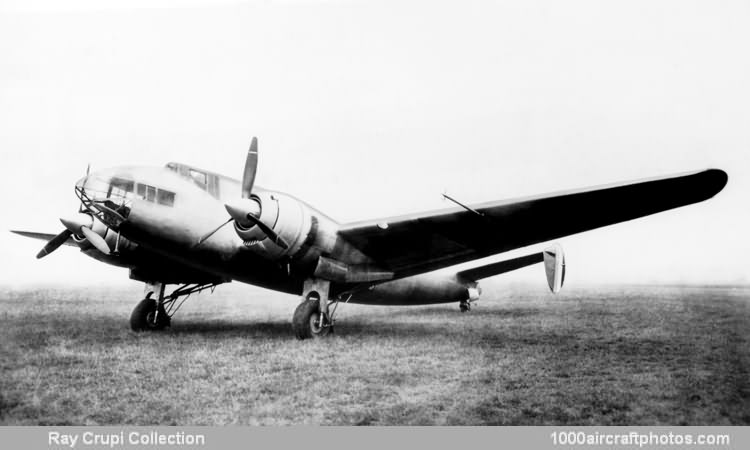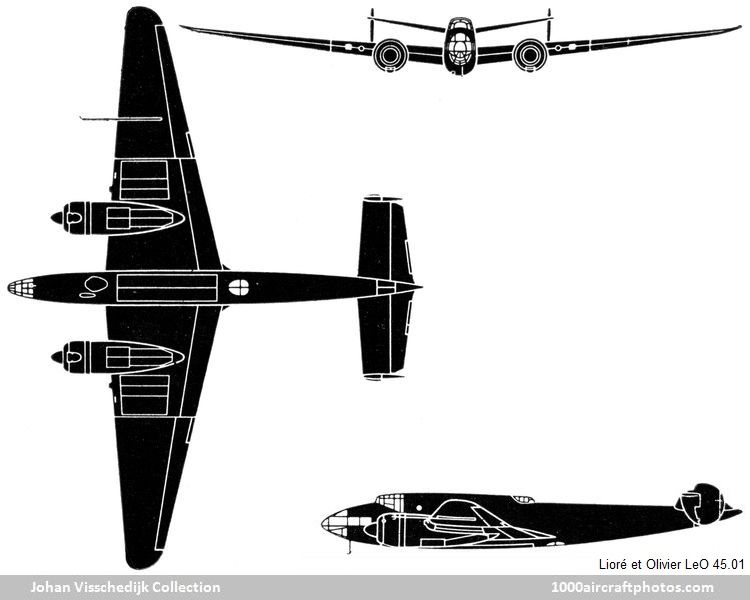11/30/2010. Remarks by Johan Visschedijk: "While French bomber design had achieved some notoriety for the unrelentingly ugly warplanes to which it had given birth, the years 1937-1938, which saw the debuts of the LeO 45 and Amiot 340, reveal all too clearly the fact that French combat aircraft designers had not been oblivious of developments in aerodynamics. Gone were the sharp angles, bulbous turrets and other drag-evoking features that had come to be considered characteristic of the French bomber. Here were graceful, exquisitely feminine curves; aircraft benefiting from every state-of-the-art aerodynamic refinement. What is more, their effeminate, almost delicate contours belied their inherent sturdiness.
The LeO 45 series of medium bombers, stemming from a specification issued on November 17, 1934 by the Service Technique de l'Aéronautique calling for a B4 aircraft, a four-seat medium bomber with a 2,646 lb (1,200 kg) bomb load, a 435 mls (700 km) radius of action and a long-range cannon defensive armament, were probably the most shapely warplanes in their category. Although relatively large and heavy, they were to prove highly maneuverable and, without bomb load, fully aerobatic. Extremely efficient and, in some respects, technically ahead of their time, they offered smooth handling characteristics and excellent engine-out performances which, coupled with their speed and effective armament, were to endear them to their crews.
Competing projects were the Amiot 341, the Latécoère 570, and the Romano 120, and the LeO 45, which, designed by a team led by Jean Mercier and built at the Argenteuil plant of the Lioré et Olivier concern, was flown for the first time on January 16, 1937, was of more advanced design concept than the other contending prototypes.
Handling characteristics of the prototype during flight trials were generally satisfactory, although there was a marked tendency to swing during take off. In an effort to rectify this shortcoming, the endplate vertical tail surfaces were redesigned and lowered, and substantially larger horn-balanced rudders were fitted, flight testing after these modifications being resumed on July 16, 1937. Official trials at the CEMA (Centre d'Essais du Materiel Aerien) began on September 2, and eight days later the LeO 45.01 attained a speed of 388 mph (624 kmh) in a shallow dive between 16,404 and 5,906 ft (5,000 and 1,800 m) .
The oil coolant radiators which were flush with the wing leading edges had, meanwhile, proved unsatisfactory, and on October 23 flight testing began with projecting radiator intakes, but the principal Achilles Heel of the prototype was its Hispano-Suiza 14AA 08/09 fourteen-cylinder air-cooled radial engines which, rated at 1,078 hp for take off and 1,100 hp at 9,350 ft (2,850 m), had been constantly troublesome, and on December 6 both power plants cut simultaneously, necessitating a forced landing in a ploughed field at Saclay. Fortunately, the prototype suffered no damage and, after replacement of the engines, succeeded in taking-off once more for Villacoublay.
Despite the unsatisfactory state of development of the Hispano-Suiza engine, this power plant was specified when an initial contract for 20 production LeO 45s was awarded in January 1938. In the following month, the LeO 45.01 was returned to the SNCASE to have Mercier engine cowlings fitted and slight dihedral applied to the wing tips, flight testing being resumed on April 30, 1938, but continued difficulties with the Hispano-Suiza engines during resumed CEMA trials finally led, on August 29, 1938, to the decision to switch to the more reliable Gnome & Rhône 14N, the prototype having completed 97 flights totaling 66 hr. 45 min. by August 29, 1938.
Re-engined with Gnome & Rhône 14N 20/21 Mistral-Major fourteen-cylinder radials rated at 1,030 hp and redesignated LeO 451.01, the prototype resumed its flight test program on October 21, 1938. In the meantime, the initial order for 20 LeO 45s together with a similar order placed on March 25, 1938 had been amended to cover the LeO 451, and an order for a further 100 aircraft had been awarded, the production of which was being initiated by the SNCASE plants at Clichy and Levallois in the suburbs of Paris, assembly being undertaken at Villacoublay.
The LeO 451.01 began CEMA tests in December 1938, attaining 311 mph (500 kmh) in level flight at 16,404 ft (5,000 m) on January 19, 1939, and successfully completing official trials during the following month. The first production aircraft, the LeO 451 No. 1, flew at Villacoublay on March 24, 1939, being followed by the second aircraft on April 28, the latter having two Gnome & Rhône 14N 39 engines, the shafts of which both rotated in a left-hand direction, although this installation was not adopted for subsequent aircraft."

